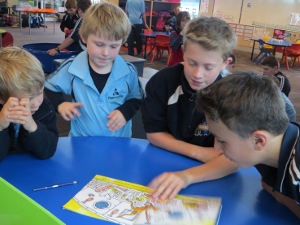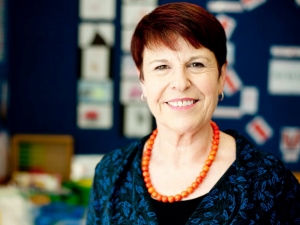Vision becomes MLE reality at Pegasus Bay School

 The brand-new Pegasus Bay School located in Pegasus Town, 25 kilometres north of Christchurch, welcomed its first students on May 5, the start of Term Two. It is the first school build to be completed as part of the Government’s $1.137 billion investment in education renewal in greater Christchurch following the earthquakes.
The brand-new Pegasus Bay School located in Pegasus Town, 25 kilometres north of Christchurch, welcomed its first students on May 5, the start of Term Two. It is the first school build to be completed as part of the Government’s $1.137 billion investment in education renewal in greater Christchurch following the earthquakes.
It has been designed as a Modern Learning Environment (MLE), the new education concept introduced by the Ministry of Education to meet the changes in teaching practices and learning needs for the 21st century.
Catering for Year 0-8 primary school students, the Pegasus Bay School roll includes children from the former Waikuku Primary School, where the roll had more than doubled from 125 to 260 as earthquake-affected Christchurch residents moved to areas north of the city.
The roll at the new school will be monitored closely, Mr Hornblow says.
“There is a house completion every second day in our catchment area so we have a strict enrolment scheme in place to limit growth of the roll as much as possible.”
Timing has been a significant factor in the development of Pegasus Bay School. As Mr Hornblow explains, “I was appointed principal at the Waikuku site six years ago and part of my role was the visioning for the new school, and building what was a small country school that needed some TLC into a large, 600-plus-pupil school.
“However, Pegasus Town didn’t take off as quickly as expected, which worked to our advantage. If we had built the school when we were originally meant to, it could have been terribly difficult to get what we wanted because the Ministry was still focused on the cell-type teaching system.
“But even if the Ministry hadn’t been promoting MLE, we would have insisted on it. The kids are getting a far better deal with MLE than with single-cell education. When Pegasus Bay School got the go-ahead we were very ready, as our visioning work was really thorough.”
Pegasus Bay School is being constructed in two stages, for 420 pupils, then 600. The design team for stage one was headed by Jasmax, who also designed the Forsyth Barr Stadium in Dunedin, Te Papa and The Cloud on Auckland’s waterfront. The main contractor was Arrow International Ltd and project manager was Aurecon. The construction budget was $14.945m, including $481,000 for the school’s priorities including furniture, equipment and ICT.
The completed first stage comprises a student common, open-plan administration facilities, performing arts practice rooms, gymnasium, and the initial teaching areas consisting of six learning communities for the initial 420 students.
“We looked at other systems as well, and when we went to talk design, we knew what we wanted,” Mr Hornblow says. “The Ministry and Jasmax gave us a huge amount of input. We were concerned that the Ministry of Education would look at cookie-cutter-type building due to the enormity of the Christchurch rebuild, but to their credit they are seeking individual community input.
“We also had major input from the school board, especially the board chair Nigel Sharplin, and the staff and students were consulted as well to get their ideas.”
Construction of the new school started in the last term of 2012 and took about 14 months to be completed and readied for occupation. Once that happened, Waikuku School began the process of moving, and during the last week of term one this year the children played their part by helping movers pack up and move the furniture.
“We did it with the kids, not to the kids,” Mr Hornblow says. “It was really important for them to be part of the move process. Waikuku School has been going for 140 years so we needed a respectful end as well as a beginning that celebrated the potential of our future.”
The decision to go with MLE means the school has no ‘standard’ classrooms, but instead has six learning communities, each being equivalent in square metres to two and a half classrooms. These communities feature a range of moveable seating and tables, with the different syndicates of teachers working together in the spaces and the students being mobile between the spaces and various student offices. School offices and ‘withdrawal rooms’, otherwise known as ‘cave space’ or the ‘fish tank’ make up the balance of the constructed area at Pegasus Bay School. These rooms give the children a quiet space where they can study and discuss ideas in smaller groups.
“That flexibility is a key point, with the furniture able to be changed around depending on the type of learning that’s going on,” Mr Hornblow says.
“There are three teachers and teacher aides to about 75 students and it works outstandingly well. It’s a collaborative environment that makes the best use of the different teachers’ skills and passions.
“When considering our vision for the new school, one of the key factors needed to be the professional development of the teaching staff. We are really deliberate about what needed to happen and is still to be done. Working every day with other teachers means the practice is deprivatised through working co-operatively and sharing ideas and that way they are getting professional development every day. It’s incredibly powerful.
“Many areas are coming to the fore that need to be addressed. The lack of readiness of our Student Management System, our appointment process, especially our job descriptions for teachers have had to change. Being a contributing, collaborative, innovative team member is just as important as being a great teacher. Our job description and expectations need to reflect this. Teaching like this is not everyone’s cup of tea though, as it requires a whole new mindshift. Teachers coming to a MLE school like Pegasus Bay are not just getting a new class – they’re getting a whole new learning community.”
Mr Hornblow says the teachers and students are thoroughly enjoying their new learning environment. We had been prototyping this style of learning at Waikuku so it was great to see how easily the pupils took to it.
“After we arrived here I asked a senior student how the new school was going. His reply was, ‘It’s like the school was built for us’.”
At the same time, he recognises that part of his challenge as principal at Pegasus Bay is selling the MLE concept to parents in what he describes as a “realistic and authentic way”.
“Their perception, correct or incorrect, is our reality,” he says. “So far, 80 per cent have taken MLE on board, while for the other 20 per cent, the jury is still out. But we are winning them over. MLE is pushing everyone’s boundaries – pupils, teachers and especially parents.”
Another significant feature of Pegasus Bay School is that it is the first net zero energy school in New Zealand. It has been designed to produce as much energy as it uses, with any spare energy going back into the grid. Four solar panels provide the school’s hot water, and photovoltaric panels installed on the roof of one block and the gymnasium produce the school’s electricity.
“Light sensors in the ceilings are part of the whole eco focus, too, with the lights automatically turning down when the room is sunny. Temperature sensors ensure that only areas needing to are being heated,” Mr Hornblow says.
Pegasus Bay School is built to the New Zealand Green Building Council’s Green Star Education 5-Star Standard, which is now the Ministry’s policy for all new schools.
With its five-star energy-saving construction Pegasus Bay School is a model for other schools being built around the country. By producing 110,000kW/h of electricity a year, the school will use approximately 75 per cent less energy than a non-five star school and save about $15,400 a year. A touch-screen TV in the school foyer enables students and staff from each learning community to check how much power is being produced and how much each one is using.
Another innovative concept Mr Hornblow has introduced at Pegasus Bay School is the place-based curriculum. The school is in a stunning and culturally significant part of New Zealand, he says, and with the historic Kaiapoi Pa a kilometre away, as well as so many significant natural features nearby, the local environment becomes an integral aspect of the students’ learning.
“As the children move through each learning community they learn and experience making a difference in our local environment, for example, growing salmon to replenish the Ashley River.
“One of the biggest challenges for this generation,” Mr Hornblow says, “is to survive this century. People say we need to leave a better planet for our children. At Pegasus Bay we say we need to leave better, more informed children for our planet. With our place-based learning there is the notion of kaitiaki, or guardianship of the Pegasus Bay area. It’s using the local environment for their learning in a meaningful way.”
Stage Two of the construction project at Pegasus Bay School will provide a further three learning communities for an additional 180 students. Future plans include a scooter track, a community garden, new playground, bouldering wall; a golf academy and surfing academy are also planned.
Weekly tours are currently being run for all those interested in seeing the new school’s facilities and how MLE operates.









